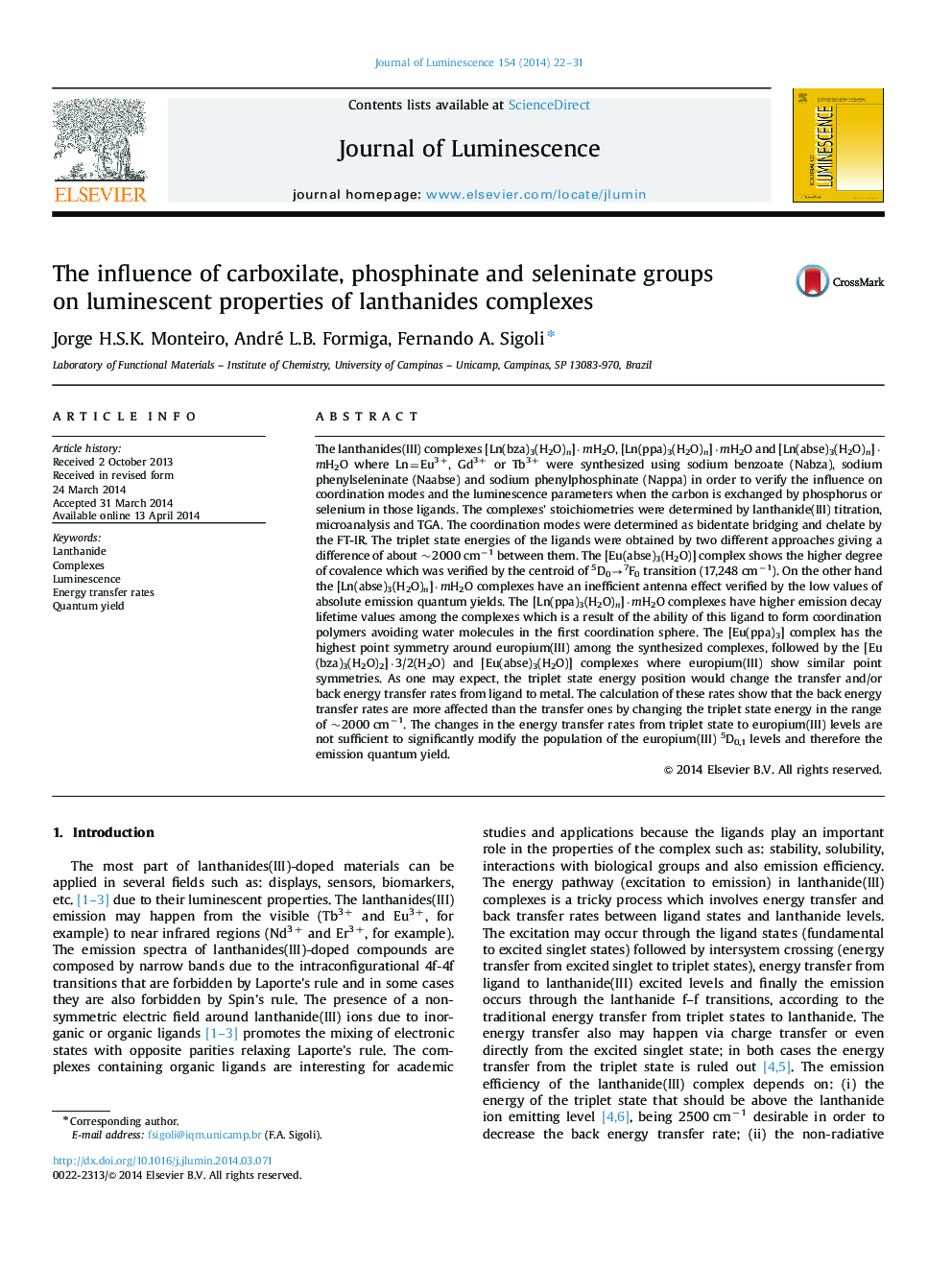| کد مقاله | کد نشریه | سال انتشار | مقاله انگلیسی | نسخه تمام متن |
|---|---|---|---|---|
| 5399735 | 1505906 | 2014 | 10 صفحه PDF | دانلود رایگان |
عنوان انگلیسی مقاله ISI
The influence of carboxilate, phosphinate and seleninate groups on luminescent properties of lanthanides complexes
ترجمه فارسی عنوان
تأثیر گروه های کربوکسیلات، فسفینت و سلنیت بر خواص لومینسانس لانتاناید
دانلود مقاله + سفارش ترجمه
دانلود مقاله ISI انگلیسی
رایگان برای ایرانیان
کلمات کلیدی
لانتانید، مجتمع ها، لومینسانس، نرخ انتقال انرژی، عملکرد کوانتومی،
موضوعات مرتبط
مهندسی و علوم پایه
شیمی
شیمی تئوریک و عملی
چکیده انگلیسی
The lanthanides(III) complexes [Ln(bza)3(H2O)n]·mH2O, [Ln(ppa)3(H2O)n]·mH2O and [Ln(abse)3(H2O)n]·mH2O where Ln=Eu3+, Gd3+ or Tb3+ were synthesized using sodium benzoate (Nabza), sodium phenylseleninate (Naabse) and sodium phenylphosphinate (Nappa) in order to verify the influence on coordination modes and the luminescence parameters when the carbon is exchanged by phosphorus or selenium in those ligands. The complexes׳ stoichiometries were determined by lanthanide(III) titration, microanalysis and TGA. The coordination modes were determined as bidentate bridging and chelate by the FT-IR. The triplet state energies of the ligands were obtained by two different approaches giving a difference of about ~2000 cmâ1 between them. The [Eu(abse)3(H2O)] complex shows the higher degree of covalence which was verified by the centroid of 5D0â7F0 transition (17,248 cmâ1). On the other hand the [Ln(abse)3(H2O)n]·mH2O complexes have an inefficient antenna effect verified by the low values of absolute emission quantum yields. The [Ln(ppa)3(H2O)n]·mH2O complexes have higher emission decay lifetime values among the complexes which is a result of the ability of this ligand to form coordination polymers avoiding water molecules in the first coordination sphere. The [Eu(ppa)3] complex has the highest point symmetry around europium(III) among the synthesized complexes, followed by the [Eu(bza)3(H2O)2]·3/2(H2O) and [Eu(abse)3(H2O)] complexes where europium(III) show similar point symmetries. As one may expect, the triplet state energy position would change the transfer and/or back energy transfer rates from ligand to metal. The calculation of these rates show that the back energy transfer rates are more affected than the transfer ones by changing the triplet state energy in the range of ~2000 cmâ1. The changes in the energy transfer rates from triplet state to europium(III) levels are not sufficient to significantly modify the population of the europium(III) 5D0,1 levels and therefore the emission quantum yield.
ناشر
Database: Elsevier - ScienceDirect (ساینس دایرکت)
Journal: Journal of Luminescence - Volume 154, October 2014, Pages 22-31
Journal: Journal of Luminescence - Volume 154, October 2014, Pages 22-31
نویسندگان
Jorge H.S.K. Monteiro, André L.B. Formiga, Fernando A. Sigoli,
